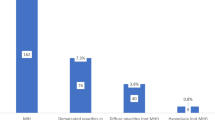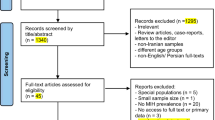Abstract
Background
Molar–incisor hypomineralisation is an enamel developmental defect highly prevalent in Lebanon. Literature suggests that perinatal conditions and childhood illnesses might be potential aetiological factors for this affection.
Aims
This case–control study aimed to investigate the association of MIH with prenatal, natal and postnatal factors amongst 7–9 years Lebanese children and to end up with recommendations to overcome its occurrence.
Methods
Self-administered, structured questionnaire including potential etiological factors was distributed to 659 MIH and non-MIH children’s parents. The analysis of data was carried out using Statistical Package for Social Sciences Computer Software (SPSS 21.0, Inc., Chicago, IL, USA). For Statistical analysis, Pearson’s chi-square, Fischer’s exact test and multivariate regression model were used. A p value of less than 0.05 was considered statistically significant.
Results
Children whose mothers had consumed food and drinks canned during pregnancy had 2.9 (CI: 1.367 to 6.187) times more likely to have MIH. Those who had history of taking antibiotics had 2.15 (CI: 1.186 to 3.909) times higher odds of MIH than those who did not have while those who had fever episodes during the early childhood years were 2.057 (CI: 1.149 to 3.683) times more likely to develop MIH.
Conclusion
During early childhood, careful handling of high fever, greater public awareness regarding misuse of antibiotics and education about bisphenol A and how to avoid it during pregnancy and breastfeeding are recommended to decrease the occurrence of MIH.


Similar content being viewed by others
Data availability
The data that support the findings of this study are available from the corresponding author, R.E., upon reasonable request.
References
Alaluusua S, Lukinmaa PL, Koskimies M, et al. Developmental dental defects associated with long breast feeding. Eur J Oral Sci. 1996;104(5–6):493–7.
Alaluusua S, Calderara P, Gerthoux PM, et al. Developmental dental aberrations after the dioxin accident in Seveso. Environ Health Perspect. 2004;112(13):1313–8.
Alaluusua S. Aetiology of molar–incisor hypomineralisation: a systematic review. Eur Arch Paediatr Dent. 2010;11(2):53–8.
Allazzam SM, Alaki SM, El Meligy OAS. Molar incisor hypomineralization, prevalence, and etiology. Int J Dent. 2014;2014:234508.
Arrow P. Risk factors in the occurrence of enamel defects of the first permanent molars among schoolchildren in Western Australia. Community Dent Oral Epidemiol. 2009;37(5):405–15.
Banu A, Șerban C, Pricop M, Urechescu H, Vlaicu B. Dental health between self-perception, clinical evaluation and body image dissatisfaction–a cross-sectional study in mixed dentition pre-pubertal children. BMC Oral Health. 2018;18(1):74.
Beentjes VEVM, Weerheijm GHJ, Grohen HJ. Factors involved in the aetiology of molar–incisor hypomineralisation (MIH). Eur J of Paediatr Dent. 2002;3(1):9–13.
Cao XL, Popovic S, Arbuckle TE, Fraser WD. Determination of free and total bisphenol A in human milk samples from Canadian women using a sensitive and selective GC-MS method. Food Addit Contam Part A Chem Anal Control Expo Risk Assess. 2015;32(1):120–5.
Cheaito L, Azizi S, Saleh N, Salameh P. Assessment of self-medication in population buying antibiotics in pharmacies: a pilot study from Beirut and its suburbs. Int J Public Health. 2014;59(2):319–27.
Crombie F, Manton D, Kilpatrick N. Aetiology of molar–incisor hypomineralization: a critical review. Int J Paediatr Dent. 2009;19(2):73–83.
de Souza JF, Gramasco M, Jeremias F, et al. Amoxicillin diminishes the thickness of the enamel matrix that is deposited during the secretory stage in rats. Int J Paediatr Dent. 2016;26(199–210):25.
Dualde P, Pardo O, Corpas-Burgos F, et al. Biomonitoring of bisphenols A, F, S in human milk and probabilistic risk assessment for breastfed infants. Sci Total Environ. 2019;668:797–805.
Elfrink ME, Ghanim A, Manton DJ, Weerheijm KL. Standardised studies on molar incisor hypomineralisation (MIH) and hypomineralised second primary molars (HSPM): a need. Eur Arch Paediatr Dent. 2015;16(3):247–55.
Elzein R, Chouery E, Abdel-Sater F, Bacho R, Ayoub F. Molar incisor hypomineralisation in Lebanon: prevalence and clinical characteristics. Eur Arch Paediatr Dent. 2019. https://doi.org/10.1007/s40368-019-00505-w.
Fatturi AL, Wambier LM, Chibinski AC, et al. A systematic review and meta-analysis of systemic exposure associated with molar incisor hypomineralization. Community Dent Oral Epidemiol. 2019;47(5):407–15.
Fayle SA. Molar incisor hypomineralisation: restorative management. Eur J Paediatr Dent. 2003;4(3):121–6.
Ghanim A, Elfrink M, Weerheijm KL, Marin˜o R, Manton D. A practical method for use in epidemiological studies on enamel hypomineralisation. Eur Arch Paediatr Dent. 2015;16(3):235–46.
Ghanim A, Manton D, Bailey D, Marino R, Morgan M. Risk factors in the occurrence of molar–incisor hypomineralization amongst a group of Iraqi children. Int J Paediatr Dent. 2013;23:197–206.
Jälevik B. Prevalence and diagnosis of molar–incisor-hypomineralisation (MIH): a systematic review. Eur Arch Paediatr Dent. 2010;11(2):59–64.
Jälevik B, Noren JG. Enamel hypomineralisation of permanent first molars: a morphological study and survey of possible aetiological factors. Int J Paediatr Dent. 2000;10:278–89.
Jälevik B, Klingberg GA. Dental treatment, dental fear and behaviour management problems in children with severe enamel hypomineralization of their permanent first molars. Int J Paediatr Dent. 2002;12(1):24–322.
Jalevik B, Noren JG, Klingberg G, Barregard L. Etiologic factors influencing the prevalence of demarcated opacities in permanent first molars in a group of Swedish children. Eur J Oral Sci. 2001;109:230–4.
Jedeon K, De la Dure-Molla M, Brookes SJ, et al. Enamel defects reflect perinatal exposure to bisphenol A. Am J Pathol. 2013;183(1):108–18.
Jedeon K, Loiodice S, Salhi K, et al. Androgen receptor involvement in rat amelogenesis an additional way for endocrine-disrupting chemicals to affect enamel synthesis. Endocrinology. 2016;157(11):4287–96.
Jeremias F, de Souza JF, Silva CM, Cordeiro RC, Zuanon AC, Santos-Pinto L. Dental caries experience and molar–incisor hypomineralization. Acta Odontol Scand. 2013a;71(3–4):870–6.
Jeremias F, Koruyucu M, Küchler EC, et al. Genes expressed in dental enamel development are associated with molar–incisor hypomineralization. Arch Oral Biol. 2013b;58(10):1434–42.
Kühnisch J, Mach D, Thiering E, et al. Respiratory diseases are associated with molar–incisor hypomineralizations. Swiss Dent J. 2014;124(3):286–93.
Laisi S, Ess A, Sahlberg C. Amoxicillin may cause molar incisor hypomineralisation. J Dent Res. 2009;88(2):132–6.
Leal SC, Oliveira TRM, Ribeiro APD. Do parents and children perceive molar–incisor hypomineralization as an oral health problem? Int J Paediatr Dent. 2017;27:372–9.
Lygidakis NA. Treatment modalities in children with teeth affected by molar-incisor enamel hypomineralisation (MIH): A systematic review. Eur Arch Paediatr Dent. 2010;11(2):65–74.
Lygidakis NA, Dimou G, Briseniou E. Molar–incisor-hypomineralisation (MIH). Retrospective clinical study in Greek children I. Prevalence and defect characteristics. Eur Arch Paediatr Dent. 2008;9(4):200–6.
Migeot V, Dupuis A, Cariot A, Albouy-Llaty M, Pierre F, Rabouan S. Bisphenol a and its chlorinated derivatives in human colostrum. Environ Sci Technol. 2013;47(23):13791–7.
Ngoc VTN, Huong LT, Van Nhon B, et al. The higher prevalence of developmental defects of enamel in the dioxin-affected region than non-dioxin-affected region: result from a cross-sectional study in Vietnam. Odontology. 2019;107(1):17–22.
Pitiphat W, Luangchaichaweng S, Pungchanchaikul P, Angwaravong O, Chansamak N. Factors associated with molar incisor hypomineralization in Thai children. Eur J Oral Sci. 2014;122:265–70.
Portella PD, Menoncin BLV, de Souza JF, de Menezes JVNB, Fraiz FC, Assunção LRDS. Impact of molar incisor hypomineralization on quality of life in children with early mixed dentition: a hierarchical approach. Int J Paediatr Dent. 2019;29(4):496–506.
Rodd HD, Boissonade FM, Day PF. Pulpal status of hypomineralized permanent molars. Pediatr Dent. 2007;29(6):514–20.
Ryynänen H, Sahlberg C, Lukinmaa PL, Alaluusua S. The effect of high temperature on the development of mouse dental enamel in vitro. Arch Oral Biol. 2014;59:400–6.
Schwendicke F, Elhennawy K, Reda S, Bekes K, Manton DJ, Krois J. Global burden of molar incisor hypomineralization. J Dent. 2018;68:10–8.
Silva MJ, Scurrah KJ, Craig JM, Manton DJ, Kilpatrick N. Etiology of molar incisor hypomineralization - a systematic review. Community Dent Oral Epidemiol. 2016;44(4):342–53.
Sönmez H, Yıldırım G, Bezgin T. Putative factors associated with molar incisor hypomineralisation: an epidemiological study. Eur Arch Paediatr Dent. 2013;14:375–80.
Suga S. Enamel hypomineralisation viewed from pattern of progressive mineralisation of human and monkey developing enamel. Adv Dent Res. 1989;3:188–98.
Weerheijm KL. Molar–incisor hypomineralisation (MIH). Eur J Paediatr Dent. 2003;4(3):114–20.
Weerheijm KL. Molar incisor hypomineralization (MIH): clinical presentation, aetiology and management. Dent Update. 2004;31(1):9–12.
Weerheijm KL, Duggal M, Mejàre I, et al. Judgement criteria for molar incisor hypomineralisation (MIH) in epidemiologic studies: a summary of the European meeting on MIH held in Athens. Eur J Paediatr Dent. 2003;4(3):110–3.
Weerheijm KL, Jälevik B, Alaluusua S. Molar–incisor hypomineralisation. Caries Res. 2001;35:390–1.
Whatling R, Fearne JM. Molar incisor hypomineralization: a study of aetiological factors in a group of UK children. Int J of Paediatr Dent. 2008;18(3):155–62.
Wuollet E, Laisi S, Salmela E, Ess A, Alaluusua S. Molar–incisor hypomineralization and the association with childhood illnesses and antibiotics in a group of Finnish children. Acta Odontol Scand. 2016;74(5):416–22.
Zahreddine L, Hallit S, Shakaroun S, Al-Hajje A, Awada S, Lahoud N. Knowledge of pharmacists and parents towards antibiotic use in pediatrics: a cross-sectional study in Lebanon. Pharm Pract (Granada). 2018;16(3):1194.
Zhang B, He Y, Zhu H, et al. Concentrations of bisphenol A and its alternatives in paired maternal-fetal urine, serum and amniotic fluid from an e-waste dismantling area in China. Environ Int. 2020;136:105407.
Funding
Not applicable.
Author information
Authors and Affiliations
Contributions
All authors contributed to the study conception and design. Material preparation, data collection and analysis were performed by Rola Elzein, and Fadi Abdel-Sater. The first draft of the manuscript was written by Rola Elzein and all authors commented on previous versions of the manuscript. All authors read and approved the final manuscript.
Corresponding author
Ethics declarations
Conflict of interest
The authors declare that they have no conflict of interest.
Ethics approval
The present study was approved by both Ethics Committees of the Lebanese University (#76/2017) and Saint-Joseph University of Beirut (#USJ-2017–143).
Consent to participate
All parents or guardians of the participating children were informed about the study before their enrolment and they gave voluntary consent.
Additional information
Publisher's Note
Springer Nature remains neutral with regard to jurisdictional claims in published maps and institutional affiliations.
Electronic supplementary material
Below is the link to the electronic supplementary material.
Rights and permissions
About this article
Cite this article
Elzein, R., Chouery, E., Abdel-Sater, F. et al. Molar–incisor hypomineralisation in Lebanon: association with prenatal, natal and postnatal factors. Eur Arch Paediatr Dent 22, 283–290 (2021). https://doi.org/10.1007/s40368-020-00555-5
Received:
Accepted:
Published:
Issue Date:
DOI: https://doi.org/10.1007/s40368-020-00555-5




